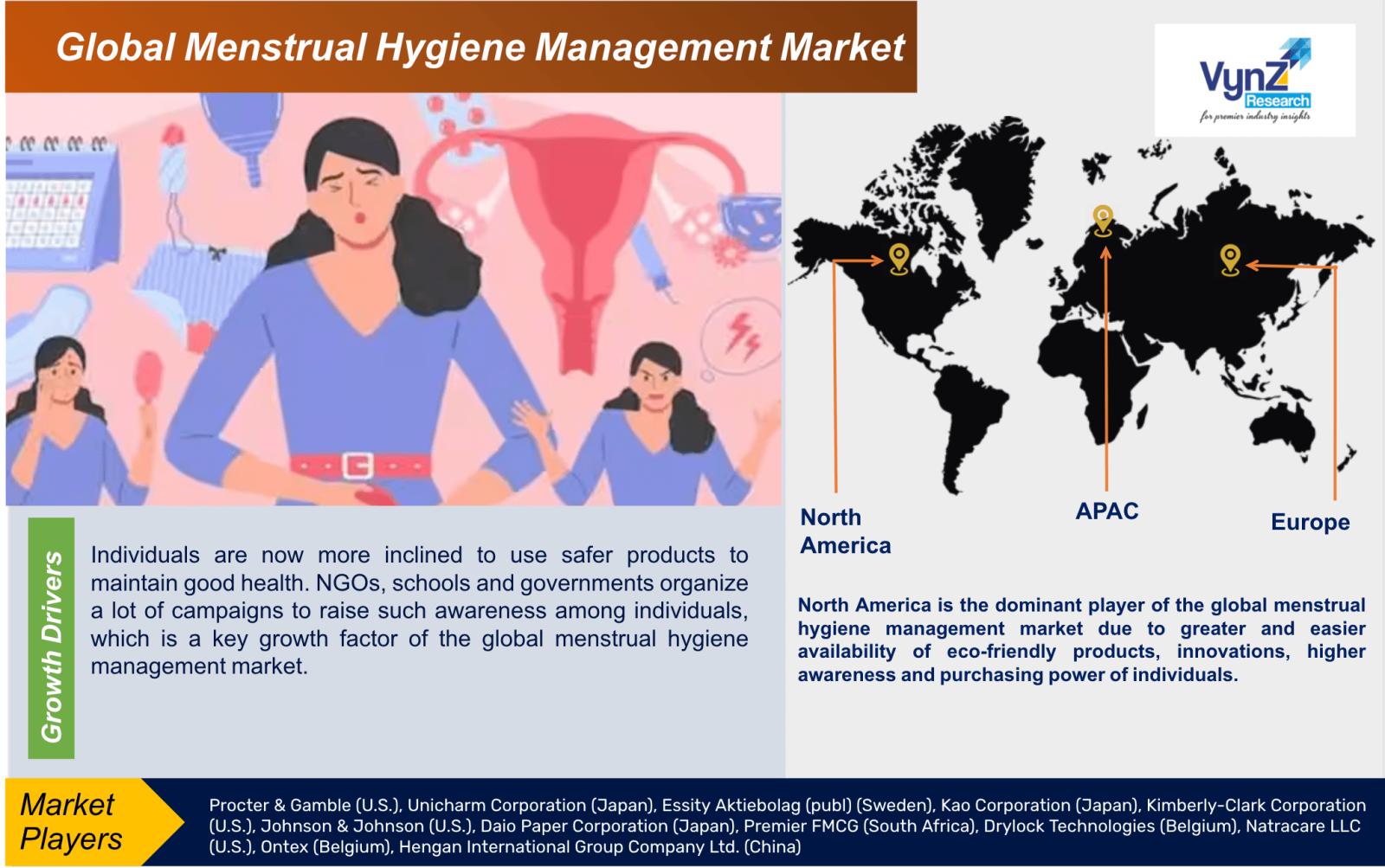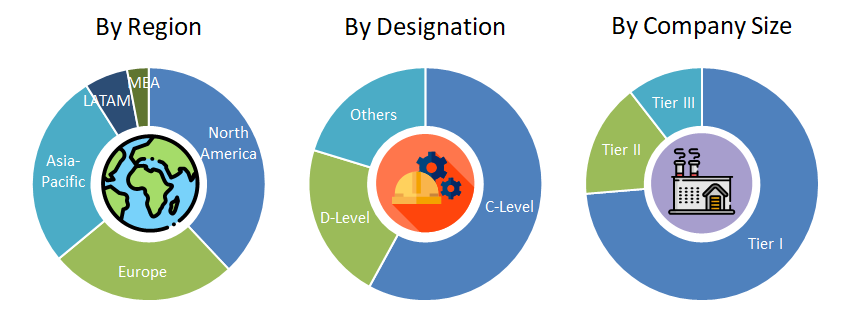Industry Overview
The global menstrual hygiene management market size was valued at USD 26.4 billion in 2023. It is likely to grow up to USD 39.4 billion by 2030 at a CAGR of 5.6% during the forecast period ranging between 2025 and 2030.

Innovative designs and sustainability of menstrual products promote the market growth. It has resulted in eco-friendly and easy-to-use products such as the menstrual cups. The high demand for them and the biodegradable pads, which is attributed to the rising awareness of their benefits among users, promote the market growth as well. This is further facilitated by the rising shift towards such products to contribute towards reducing environmental impacts and carbon footprint.
Menstrual hygiene management implies the practices to ensure there is no infection or adverse effects of using inferior products. It involves keeping the private parts clean, using safe menstrual products and proper disposal. Such practices help promote overall health by reducing chances of infections. It also gives additional confidence to women in schools and workplaces while taking part in different activities.
Global Menstrual Hygiene Management Market Trends/ Growth Drivers:
Increased consciousness about menstrual hygiene and awareness
Individuals are now more inclined to use safer products to maintain good health. NGOs, schools and governments organize a lot of campaigns to raise such awareness among individuals, which is a key growth factor of the global menstrual hygiene management market.
Other factors that influence the growth of the market include easier availability and accessibility through a large number of e-commerce platforms, higher disposable income, and urbanization. The menstrual products available today are safer and better due to the advancement in technology and innovation in product type and design. Additionally, apps to track menstrual periods also helps promote menstrual hygiene management and the market growth. Initiatives by the governments and media to destigmatize menstruation, free distribution and subsidies on menstrual products also influence the market growth.
Global Menstrual Hygiene Management Market Challenges
Accessibility issues among low-income groups and regions
The growth of the global menstrual hygiene management market is hindered mainly due to the limited accessibility of menstrual products in low-income regions and people living there. Lack of a proper and strong infrastructure and poverty pose further growth challenge to the market.
Global Menstrual Hygiene Management Market Opportunities
Rising demand of menstrual products
People are now looking for more sustainable and biodegradable menstrual products for safety and hygiene, which offers significant growth openings to the global menstrual hygiene management market. Notable shift due to environmental awareness creates opportunities for market expansion in developed countries especially. Localized processing and product development also offers growth opportunities in developing countries. Rise of e-commerce platforms, CSR programs, government initiatives to increase awareness further offers growth avenues to the market.
Global Menstrual Hygiene Management Market Report Coverage
|
Report Metric
|
Details
|
|
Historical Period
|
2018 - 2023
|
|
Base Year Considered
|
2024
|
|
Forecast Period
|
2025 - 2030
|
|
Market Size in 2024
|
U.S.D. 26.4 Billion
|
|
Revenue Forecast in 2030
|
U.S.D. 39.4 Billion
|
|
Growth Rate
|
5.6%
|
|
Segments Covered in the Report
|
Product Type, Distribution Channel, Age Group and Material Type
|
|
Report Scope
|
Market Trends, Drivers, and Restraints; Revenue Estimation and Forecast; Segmentation Analysis; Impact of COVID-19; Companies’ Strategic Developments; Market Share Analysis of Key Players; Company Profiling
|
|
Regions Covered in the Report
|
North America, Europe, Asia Pacific and Rest of the World
|
Global Menstrual Hygiene Management Market Segmentation
VynZ Research provides an analysis of the key trends in each segment of the menstrual hygiene management market report, along with forecasts at the regional and country levels from 2025-2030. Our report has categorized the market based on Product Type, Distribution Channel, Age Group and Material Type
Insight by Product Type
- Sanitary Pads
- Tampons
- Menstrual Cups
- Others
Sanitary pads dominate due to higher availability
The global menstrual hygiene management market is divided by product type into Sanitary Pads, Tampons, Menstrual Cups, and others, where the sanitary pads segment dominatesthe market and is expected to grow more during the projected period due to higher availability.
Insight by Distribution Channel
- Supermarkets
- Hypermarkets
- Pharmacies
- Online Stores
- Others
Online stores segment dominates due to convenience
Based on the different distribution channels, the global menstrual hygiene management market is divided into Supermarkets, Hypermarkets, Pharmacies, Online Stores, and others. The online stores segment dominates the market due to convenience in making discreet purchases and wider variety of menstrual products available in one place.
Insight by Age Group
Adolescents segment dominates due to increased awareness
Different age groups divide the global menstrual hygiene management market into Adolescents and Adults categories, where the former leads the market for higher awareness of the benefits of using menstrual products.
Insight by Material Type
- Synthetic
- Organic
- Hybrid subsections
Organic material segment dominates due to higher consumer preference
Different types of materials used in making these products divide the global menstrual hygiene management market into Synthetic, Organic, and Hybrid subsections. Among them the organic material segment will dominate the market due to higher consumer preference among environmentally conscious individuals.
Global Menstrual Hygiene Management Market: Geographic Overview
- North America
- Europe
- Germany
- U.K.
- France
- Italy
- Spain
- Russia
- Rest of Europe
- Asia-Pacific (APAC)
- China
- Japan
- India
- South Korea
- Vietnam
- Thailand
- Malaysia
- Rest of Asia-Pacific
- Rest of the World (RoW)
- Brazil
- Saudi Arabia
- South Africa
- U.A.E.
- Other Countries
North America is the dominant player of the global menstrual hygiene management market due to greater and easier availability of eco-friendly products, innovations, higher awareness and purchasing power of individuals.
The Asia-Pacific region is showing higher growth prospects during the study period due to growing awareness which is further facilitated by the government initiatives, greater economic development and urbanization drives, and improved access.
Europe is showing steady growth due to consistently high demand for sustainable menstrual products and high awareness along with supportive government policies to reduce taxes on these products, which eventually augments market approachability.
Global Menstrual Hygiene Management Market: Competitive Insights
- Procter & Gamble (U.S.)
- Unicharm Corporation (Japan)
- Essity Aktiebolag (publ) (Sweden)
- Kao Corporation (Japan)
- Kimberly-Clark Corporation (U.S.)
- Johnson & Johnson (U.S.)
- Daio Paper Corporation (Japan)
- Premier FMCG (South Africa)
- Drylock Technologies (Belgium)
- Natracare LLC (U.S.)
- Ontex (Belgium)
- Hengan International Group Company Ltd. (China)
Global Menstrual Hygiene Management Market: Recent Developments
Unicharm Corporation has launched anti-bacteria range called SOFY. It is safer with an innovative herbal shield to prevent skin infection and six-layer padding for deep absorption and preventing leakage.
Procter & Gamble has launched their innovative cotton-based Always Pure and Tampax Pure products to offer higher sustainable and eco-friendly product option.





